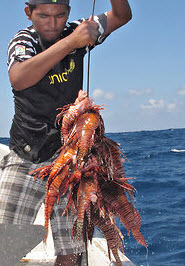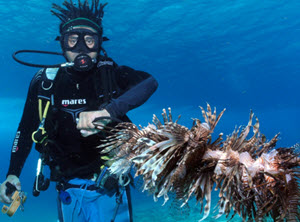 Lionfish are very beautiful fish. Unfortunately they have become a scourge that is quickly spreading through out the Caribbean ocean. They are decimating other fish populations as they go. The Lionfish is not native to the Caribbean and without any predators that eat them they are able to reproduce quickly. They are ferocious hunters and that is why their presence can be devastating on a reef. Lionfish is thought to be reducing Atlantic reef diversity by up to 80% in areas where they get established.
Lionfish are very beautiful fish. Unfortunately they have become a scourge that is quickly spreading through out the Caribbean ocean. They are decimating other fish populations as they go. The Lionfish is not native to the Caribbean and without any predators that eat them they are able to reproduce quickly. They are ferocious hunters and that is why their presence can be devastating on a reef. Lionfish is thought to be reducing Atlantic reef diversity by up to 80% in areas where they get established.
Divers play an important role in fighting this invasion and in educating the public of the treat that lionfish pose to the Atlantic reef diversity. As such we think that all divers all over the world should be aware of the situation and what to do if they see a lionfish while diving in the Caribbean ocean.
Lionfish Intro
 Lionfish is a group of fish consisting of 10 species all native to the Indo-Pacific. Two of these species have been introduced to the Caribbean. Red lionfish (P. volitans) and the common lionfish (P. miles). In this article I will be referring to the Red lionfish (P. volitans) when i say lionfish, The Red lionfish (P. volitans) can grow to be 47 cm (18.5 in) and live up to 10 years. They have venomous spines that keep them safe from most predators. Sharks and Groupers do however seem to be immune to the spines.
Lionfish is a group of fish consisting of 10 species all native to the Indo-Pacific. Two of these species have been introduced to the Caribbean. Red lionfish (P. volitans) and the common lionfish (P. miles). In this article I will be referring to the Red lionfish (P. volitans) when i say lionfish, The Red lionfish (P. volitans) can grow to be 47 cm (18.5 in) and live up to 10 years. They have venomous spines that keep them safe from most predators. Sharks and Groupers do however seem to be immune to the spines.
The species can reproduce where quickly. Females can produce 30 000 eggs every four days and more than 2 million eggs per year. The fry quickly reach sexual maturity. It is estimated that 27% of all mature fish would need to be harvested by humans and predators every month to keep the population levels from raising.
It is important to remember that the species is only an invasive plague in the Caribbean. In the Indo-Pacific they are an integral part of the ecosystem.
How the Lionfish got introduced to the Caribbean
There are a lot of myths about how the lionfish got introduced to the Caribbean and it is often said that they got released when hurricane Andrew destroyed an public aquarium and released them into the Biscayne Bay. Although it is possible that the hurricane did release lionfish into the Caribbean we know that this was not the source of the invasion. Hurricane Andrew hit Florida in 1992. The first Lionfish sighting took place in 1985, seven years before the hurricane.
 The lionfish (P. volitans) in the Caribbean are very similar to Lionfish from the Philippines. This causes many to believe that the source of the invasion are fish that entered the country through the aquarium trade and then likely got released by an irresponsible aquarium owner. It is believed that the entire population derive from 6-8 fish. There is however no definitive evidence that proves that the fish where released from the aquarium trade. This does however seems to be the most plausible explanation for the invasion. Other theories includes larvae hitching a ride with ballast water of a ship or with a delivery of fry to an aquaculture farm. Both these explanation are possible but seems less likely. The Lionfish around the Bahamas might be of another origin than those of the coast of Florida.
The lionfish (P. volitans) in the Caribbean are very similar to Lionfish from the Philippines. This causes many to believe that the source of the invasion are fish that entered the country through the aquarium trade and then likely got released by an irresponsible aquarium owner. It is believed that the entire population derive from 6-8 fish. There is however no definitive evidence that proves that the fish where released from the aquarium trade. This does however seems to be the most plausible explanation for the invasion. Other theories includes larvae hitching a ride with ballast water of a ship or with a delivery of fry to an aquaculture farm. Both these explanation are possible but seems less likely. The Lionfish around the Bahamas might be of another origin than those of the coast of Florida.
About 93% of all lionfish in the Caribbean is red lionfish (P. volitans). The common lionfish (P. miles) also have established themself but they only make up about 7% of the lionfish in the Caribbean. Little is known how the common lionfish (P. miles) was introduced but many of the same theories applies.
How to fight it
 The Lionfish does not have any natural predators in the Caribbean. There are several groups of divers trying to train native species to eat lionfish. By feeding sharks, groupers and other large species lionfish that hope to get them to associate lionfish with food and start hunting then. Divers in Honduras and other areas have seen limited success and have been able to get sharks to start hunting sharks. This will however only have regional affect unless sharks and other predators start learning from each other and spread the behavior. Divers also clear certain reefs from lionfish by hunting them with spears. This method can be very effective on local areas but does little to remove the species from the Caribbean as a whole. “lionfish derbys” can be very beneficial to the reefs where they are held and they also help raise awareness for the problem. The derbys also help raise awareness of the fact that the lionfish is a very tasty food fish and introducing them to the menu of more people might be key to stopping this species. The lionfish could become an important economic species since they have a very high resilience to fishing due to their high reproductive rate.
The Lionfish does not have any natural predators in the Caribbean. There are several groups of divers trying to train native species to eat lionfish. By feeding sharks, groupers and other large species lionfish that hope to get them to associate lionfish with food and start hunting then. Divers in Honduras and other areas have seen limited success and have been able to get sharks to start hunting sharks. This will however only have regional affect unless sharks and other predators start learning from each other and spread the behavior. Divers also clear certain reefs from lionfish by hunting them with spears. This method can be very effective on local areas but does little to remove the species from the Caribbean as a whole. “lionfish derbys” can be very beneficial to the reefs where they are held and they also help raise awareness for the problem. The derbys also help raise awareness of the fact that the lionfish is a very tasty food fish and introducing them to the menu of more people might be key to stopping this species. The lionfish could become an important economic species since they have a very high resilience to fishing due to their high reproductive rate.
 NOAA is researching methods for managing the species and is looking at what reduces their numbers within their natural range.
NOAA is researching methods for managing the species and is looking at what reduces their numbers within their natural range.
Until a better solution is found we recommend that you kill any lionfish you see and can safely kill while diving in the Caribbean. Remember that they are native to areas such as the Red Sea and Asia and should never be killed when you see them there.

